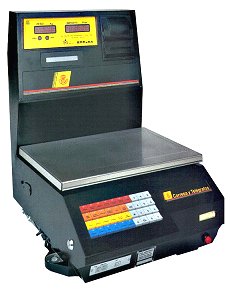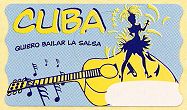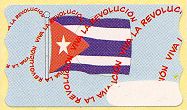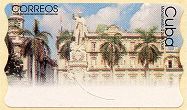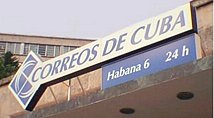Around the middle of the 90's, Correos de Cuba (the Cuban postal administration) began a modernization plan for their post offices which included the purchase of nearly 500 Correos Comercial scales and different types of weighing equipment from the Spanish company EPELSA. These balances allowed the cost of a letter or parcel based on its weight, destination and shipment type, to be determined, but which did not issue any type of stamp.
For this demonstration, they asked the Spanish company OVELAR, S.A. to manufacture some rolls of thermal self-adhesive test labels, with some simple designs, based on subjects related to Cuba, and that would be used to show the interesting philatelic options of the proposal. The result were these 4 appropriate designs:
The labels have similar characteristics to those made to order by the RCM-FNMT for the Spanish Correos in the same period. They are manufactured on self-adhesive thermal paper (non phosphorescent, in these examples), sized 47 x 27 mm, and present identical wavy sides and a central security cutting.
The EPELSA proposal was initially accepted. Meanwhile, Spanish Correos and Epelsa began a renewal plan that, on the occasion of the change to the Euro, would replace all the old Epelsa ET-CB franking scales, still in service in the Correos post offices, with the new ET-RL/T balances which were adapted in preparation for the change to the new currency. In order to be able to assist Cuba Correos with an acceptable and economic opportunity, Epelsa offered these ET-CB scales, on advantageous terms, to tempt Correos de Cuba to take advantage of these, as well as changing the logo of the postal administration and adapting them to the Cuba tariff system. So, on April 24th 2000, Correos de Cuba decided to computerize the counters of its post offices with these balances and, from that date, about 500 Epelsa ET-CB franking scales were distributed, through a local representative, to all the country’s post offices. Just as in Spain, with the Correos IRIS system, the franking scales in Cuba would also be connected through a national postal services management application called Mercurio, developed by the Cuban ICID (Instituto Central de Investigaciones Digitales). They also decided on the first two labels to be used in the franking scales. Being based on the experience and characteristics of the thermal type ATM issues of Spain, the manufacture of the rolls of thermal self-adhesive labels was again given to the OVELAR, S.A. company. The designs were adapted from pictures supplied by Correos de Cuba, which showed the monument to José Martí in the Parque Central of Havana, and the Castillo de los Tres Reyes del Morro (El Morro Castle or Fortress), in a view from the popular Havana Malecon.
As with the 4 rolls of test labels, these new ones have similar characteristics to those used by the Spanish Correos. They are manufactured on self-adhesive, non phosphorescent, thermal paper, sized 47 x 27.3 mm, and include the wavy sides and the central security score, although, by way of a difference, the score was moved downwards to the lower part of the labels, towards the area reserved for the thermal impression of the franking scales. The impression of the design is by offset and, as an additional security measure, there is the microtext CORREOSCORREOSCORREOSCORREOS in one continuous line, immediately beneath the word CORREOS, on each stamp. These initial designs, approved by the managers of the Cuban Posts, were manufactured in the Spring of 2000, with an approximate printing of 25,000 labels for each design.
The indecision about the use of the bar code, plus the introduction of a new computer system and later, different changes and internal problems within Correos de Cuba, brought this interesting postal and philatelic proposal to a halt, and currently the balances are only used to weigh and to establish the correct postage rate, but they do not issue stamps anymore. (1) Unfortunately, as we are close to our edition deadline, and we do not have any example(s) of the ATMs issued at this time, probably the ‘life’ of these items may have only been for a few hours, although they exist, and we hope to be able to show them later.
© J. Jove - M. Sans. ATEEME. Variable value stamps study group. All rights reserved This page was created in 2000 and last updated: 05.07.08 . English edition rewritten by S. Goodman (05.07.08) |

